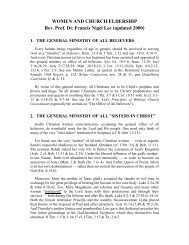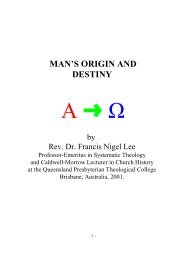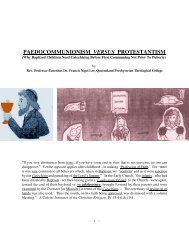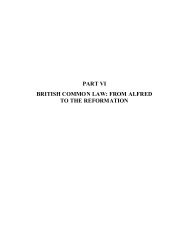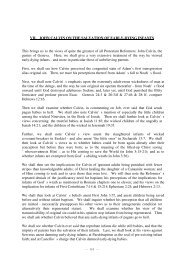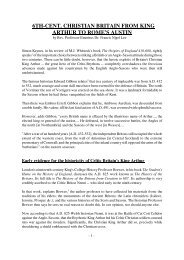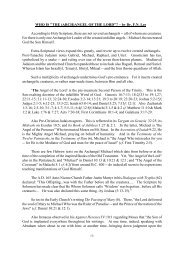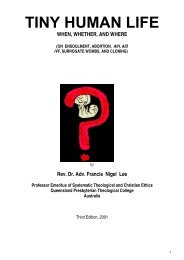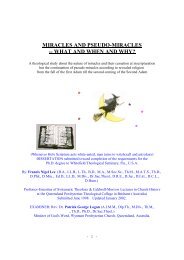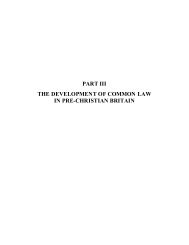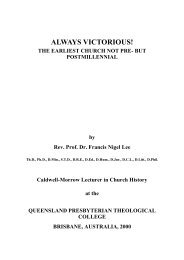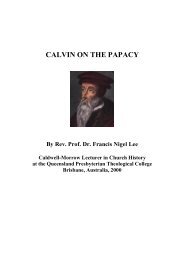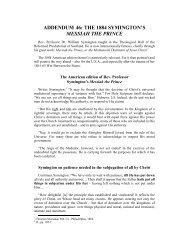THE CHRISTIAN AFRIKANERS - The Works of F. N. Lee
THE CHRISTIAN AFRIKANERS - The Works of F. N. Lee
THE CHRISTIAN AFRIKANERS - The Works of F. N. Lee
You also want an ePaper? Increase the reach of your titles
YUMPU automatically turns print PDFs into web optimized ePapers that Google loves.
station -- to help the Dutch ships on their way through to Indonesia (where the real wealth was).<strong>The</strong> following resolution was taken: "May we live in good association with South Africa, and intime employ some <strong>of</strong> her children (meaning the small numbers <strong>of</strong> yellow-skinned Hottentots) asservants and helpers, and train them in the Christian religion. Thus, if it pleases Almighty God tobless these good matters, may many be brought to the Reformed Christian religion and to God. Assuch, may the building <strong>of</strong> a fort and a garden and a town at the Cape -- Cape Town -- not onlyredound to the advantage and pr<strong>of</strong>it <strong>of</strong> the honourable Dutch East India Company. May it alsoredound for the preservation and salvation <strong>of</strong> many human lives. That is the most important aspectin the magnification <strong>of</strong> God's most holy Name and the propagation <strong>of</strong> His Holy Gospel. <strong>The</strong>rebyyour honourable Company's activities throughout Indonesia will undoubtedly more and more beblessed!"And so it was that two years later, the Dutch East India Company decided to establish this colony atthe southern tip <strong>of</strong> Africa. As its governor, it sent out Dr. Johan van Riebeeck MD, a Calvinistphysician. He was married to a French speaking Huguenot lady, Marie de Quellerie. Three shipscame sailing. <strong>The</strong>y brought with them to the southern tip <strong>of</strong> Africa the Heidelberg Catechism, theBelgian Confession, the five-point "Tulip" Decrees <strong>of</strong> Dordt, the Dordt Dutch Bible -- and also acommission from the Presbytery <strong>of</strong> Amsterdam to establish a congregation <strong>of</strong> the Reformedreligion in Southern Africa. <strong>The</strong>y brought with them the influence <strong>of</strong> Luther and especially <strong>of</strong> JohnCalvin. That has been precious in South Africa ever since.<strong>The</strong> godly governor Johan van Riebeeck MD caught sight <strong>of</strong> Table Mountain -- flat as a pancake ontop; a mile high; soaring up out <strong>of</strong> the sea. As the waves were crashing against the beach, he gotdown on his knees on the sand and prayed the following prayer:"0 merciful gracious God and heavenly Father! as it has pleased Thy Divine Majesty to call us hereat the Cape <strong>of</strong> Good Hope to gather, with our own Council, in Thy holy Name -- may we makesuch decisions as maintain justice and, if it be possible, implant and expand Thy true ReformedChristian religion in Thy good time among these wild and brutal natives to the praise and honour <strong>of</strong>Thy Name. This we pray and desire in the Name <strong>of</strong> Thy dear Son, our Mediator and Saviour, JesusChrist. Amen!"Six months later, on the l4th <strong>of</strong> October 1652 -- to be followed by other enactments in 1665 --Governor van Riebeeck enacted measures against Sabbath desecration. Thus Sunday Observancehas always been the political policy and social pattern <strong>of</strong> South Africa ever since the advent <strong>of</strong> itscivilisation -- even to this very day. Abstentions from Sunday worship at the Cape were punishedby confiscation <strong>of</strong> six day's wine ration for the first transgression; by forfeiture <strong>of</strong> one month'ssalary for the second transgression; and by a sentence <strong>of</strong> one year's unpaid labour in chains for thethird transgression.<strong>The</strong> Dutch built a castle, and cultivated fresh vegetables all the way from Table Bay to Wynberg(the "Mountain <strong>of</strong> Wine"). At Kirstenbosch, they erected a hedge: to demarcate the boundarybetween the new White settlers -- and the yellow-skinned people who wandered around withoutowning land. Thus South Africa adopted a policy <strong>of</strong> territorial racial segregation, as much aspossible, from its beginning -- and ever since.Of course, there was some miscegenation and intermarriage between the first Dutchmen thatarrived there -- and some <strong>of</strong> those yellow-skinned women. For there were not yet any Whitewomen at the Cape. As Soon as the yellow-skinned women were baptized in the Name <strong>of</strong> theTrinity, they were treated on the basis <strong>of</strong> complete equality -- and intermarriage was permitted. Butit was soon discovered that there were still cultural differences between the Hottentots and the



